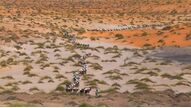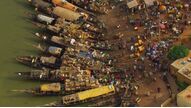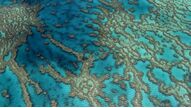Posted directly, e means 100 million
Life appeared 40e years ago Humans appeared 200,000 years ago
Earth's primordial atmosphere: dense full of water and co2
At moderate distances, liquid water forms rain, which in turn forms rivers, rivers cut terrain, form valleys and oceans, dissolve minerals in rocks, seawater changes to salt
Metal minerals star dust red iron black carbon blue copper yellow sulfur
There are archaea in the hot springs of the earth. The cyanobacteria survive by the heat of the earth. The cyanobacteria survive through the photosynthesis of the sun.
The Grand Canyon of Colorado shows a 20e-year history of sedimentation of CO2 absorbed in the ocean in the past
Plants bring oxygen to the atmosphere
From ancient times to the present, it is a kind of water that freezes to form a protective layer to help underwater creatures survive
Seventy percent of the oxygen comes from seaweed Seaweed gives color to the ocean Seaweed and shellfish form coral
Trees are the only biological trees that grow upwards that make soil biodiversity plants
Species life is always a mystery
Humans appear to build ships and become navigators
The first towns appeared 6k years ago civilized towns enabled barter and idea exchange
The genius of man is to discover his own weaknesses
agriculture 8k-1w years ago changed beastized human beings first human revolution human learning the relationship between climate and crops a prerequisite for human survival half human still farming 3/4 bit manual farming
The human population has tripled in the past 60 years. 20e people are urbanized. Half of the population now lives in cities.
Elevators make skyscrapers possible
300w farmers in the US feed 20e people dependent on oil (status needs to be updated)
70percent of human water consumption for irrigation
Pesticides seep into soil, groundwater, oceans
Three-quarters of crops cultivated over thousands of years have become extinct
Meat: It takes 13,000 liters of water to raise 1 kilogram of beef in a centralized manner
LA: There are almost as many cars as there are people
The urbanization of developed countries has become a model and a universal human dream
Mining is everywhere in the next 20 years, the amount of human mining will exceed the sum of the past 80% of the mining income will be shared by 20% of mankind
By the end of the century humanity will use up all the resources on earth
Ninety percent of all shipments take place at sea
Dubai is the pinnacle of the Western model Building artificial islands Building ski runs in the desert Importing water resources without using solar panels
marine world: Creatures in 3/4 of Earth's oceans are a mystery since 1950, fishery production has quintupled
Crisis for marine life: shrinking habitat / famine: not enough food / seabirds go further and further
5e people live in deserts larger than the total population of Europe. Circular farmland built around irrigation pipes located in the center. Relies on native groundwater (wells) Groundwater is non-renewable. Israel turns deserts into greenhouses.
The Jordan River has almost dried up and cannot flow into the Dead Sea, causing the sea level to drop and the salinity to rise to form a salt island
India may be the country most affected by water scarcity in the next century. In order to feed a large population, 30% of the wells are being abandoned. The submerged aquifer is starting to dry up. Indian women dig reservoirs by hand.
Las Vegas was built in a desert and they are the most water-using population (why)
The headwaters of the Colorado River are shrinking, the water levels of the storage lakes are dropping in half
Wetlands: 6% of the Earth's surface area Swamps are sponges of the Earth (absorbing water when wet and releasing water when dry) Essential for water purification and regeneration The environment is not suitable for human survival Converted to farms or cultivated land Half of the swamps have been destroyed in the past century
Forests Provide Rainwater Storage Carbon Prevent Soil Erosion Adjust Climate Provide Habitat
Mangroves: the nursery of the ocean, their roots feed mollusks and fish that grow along the coast to withstand tsunamis
deforestation Borneo's forests are turned into single palm trees for palm oil and eucalyptus plantations are increasingly blocked for paper making
A single forest is not a forest A forest cannot replace another forest
Haiti: Deforestation is the only way out 1/3 of the world's population depends on carbon
Madagascar: Rain erodes soil to form deep pits
Easter Island: Once a glorious history as a Pacific civilization, it became extinct due to exhaustion of resources. Only the statues of Easter Island remain
Nigeria: Africa's largest oil exporter, but 70 percent of its people are below the poverty line Half of the world's poor live in resource-rich countries
Lagos: Immigrants not to get rich but to survive
CO2 warming the North and South Poles allows ships to sail without enough glaciers to reflect sunlight Sea water is heated up by 20 percent in Arctic ice cap in 30 years Sea level rise in sea level sensitive corals lost 30 percent of glacier thickness in 40 years reduced by 40 percent
Thawing of methane permafrost in the basement of Siberia will release methane and exacerbate global warming
2e people will be climate refugees by 2050
Eco-friendly city in Freiburg, Germany
20% of the population consumes 80% of the resources
Global annual military spending exceeds 12 times the cost of supporting developing countries
5k people die every day from drinking water pollution 10e people have no access to safe drinking water 10e people face famine
50 percent of global food trade is used to feed or manufacture biofuels
40 percent of arable farmland suffers long-term damage
1300w hectares (13w square kilometers) of forests disappear every year
Species die 1,000 times faster than they reproduce
Average temperature over the past 15 years is the highest on record
View more about Home reviews









